How to Conduct Team Check-Ins to Boost Employee Engagement

Sorry, there were no results found for “”
Sorry, there were no results found for “”
Sorry, there were no results found for “”
When was the last time a team member came to you with an idea or a concern?
Chances are, it didn’t happen out of the blue—it happened because they felt there was space to talk.
Team check-ins provide that space.
They’re a chance to connect with your team, address what’s working and what’s not, and create an environment where everyone feels heard.
Let’s explore how to make these conversations truly meaningful. 💬
💬 Team check-ins are short meetings to enhance team communication and alignment
🌟 Regular check-ins improve trust, problem-solving, and adaptability
📅 Daily, weekly, and monthly check-ins serve different team and project needs
📝 Set clear agendas and focus discussions on goals, challenges, and feedback
👥 Managers play a crucial role in fostering transparency and engagement
🛠️ Tools like ClickUp streamline scheduling, documentation, and follow-ups
🎉 Flexibility in format and celebrating small wins keep check-ins effective
A check-in is a short, structured meeting to keep teams connected and aligned. It provides a dedicated time to share updates, discuss challenges, and ensure everyone is clear on priorities.
Unlike formal meetings, check-ins focus on maintaining momentum and addressing immediate needs without derailing the day. These meetings are less about rigid agendas and more about creating an open environment where team members feel comfortable speaking up.
Understanding the difference between check-ins and one-on-one meetings is key to using them effectively. 👇
| Aspect | Check-ins | One-on-one meetings |
| Who’s involved | Entire team | Project manager and one team member |
| Purpose | Focuses on team alignment and project updates | Centers on personal growth and challenges |
| Style | Collaborative and group-oriented | Individualized and private |
| Timing | Short (15-30 minutes) | Longer (30-60 minutes) |
Here are some key advantages of organizing regular team check-ins. 🧑💻
🧠 Fun Fact: The concept of ‘check-ins’ originated in agile project management methodologies during the 1990s.
Check-ins come in different shapes and sizes, each serving a unique purpose depending on the team’s needs and the project at hand. While the goal remains the same, different types of check-ins help teams stay on track in varied ways.
Let’s explore. 🗂️
Daily check-ins are short, focused team meetings where individuals provide quick progress updates, identify blockers, and clarify immediate priorities.
These check-ins are often used in fast-paced environments like agile teams, where constant communication is necessary to maintain momentum.
📌 Example: Daily stand-ups in agile teams are a great example. During these meetings, team members typically answer three key questions: What did you do yesterday? What are you working on today? What’s blocking your progress? This structure ensures the team stays aligned and any potential blockers are quickly addressed, preventing project delays.
Weekly check-ins are slightly longer and serve as a touchpoint to review progress made over the week, align on upcoming priorities, and ensure tasks are on track for the upcoming week. They typically cover task completion, progress on goals, and any required short-term planning.
📌 Example: A marketing team might hold weekly check-ins to discuss the status of content projects, social media campaigns, or upcoming product launches. During these meetings, the team reviews what’s been accomplished, adjusts timelines if necessary, and aligns on the key priorities for the following week.
📖 Also Read: 15 Free Annual Employee Performance Review Templates
Monthly check-ins focus more on long-term progress, reflecting on overall performance and addressing bigger challenges or obstacles that may have cropped up. These meetings provide a space to set goals for the month ahead, identify trends, and evaluate progress toward larger objectives.
📌 Example: In a sales team, monthly check-ins might be used to review performance against sales targets, assess pipeline health, and adjust strategies for upcoming campaigns. These meetings offer a chance to celebrate wins, identify areas for improvement, and adjust tactics for next month’s goals.
Project-specific check-ins are tailored to meet the needs of specific projects and milestones.
They are particularly useful for ensuring cross-functional teams stay aligned and everyone is on the same page regarding the project’s timeline and deliverables.
📌 Example: A product development team working on a new feature might hold a weekly project-specific check-in. During these meetings, the team discusses the progress made on the feature’s development, reviews user feedback, and identifies any technical or design challenges that need to be addressed.
🧠 Fun Fact: Stand-up meetings originated in the tech industry to prevent long, drawn-out discussions.
Ad hoc check-ins happen as needed, typically in response to urgent issues or opportunities for collaboration. These project meetings are often informal and take place when something unexpected arises, requiring immediate attention or realignment.
📌 Example: If a sudden bug is discovered in a software release that could impact customers, an ad hoc check-in might be called to quickly assess the situation, assign resources to resolve the issue, and communicate with necessary stakeholders to prevent any customer-facing issues.
Keeping up with your team doesn’t have to be complicated. The right approach to check-ins can make all the difference.
Here’s how you can structure meaningful check-ins to make them impactful for employees and managers alike. 👥
A clear agenda is essential to keep the conversation focused and productive. While the specifics may vary depending on the frequency of the check-in, here are some guidelines:
Check-ins should never feel like a chore. Engaging employees in meaningful conversations ensures they feel valued and heard.
Focus on these discussion points:
💡 Pro Tip: Incorporate employee satisfaction survey questions during check-ins to gain valuable insights into team morale. Asking open-ended, fun check-in questions about workload, communication, and workplace culture helps identify areas for improvement for a more motivated team.
Transparency builds trust, enabling employees to share their true thoughts without hesitation. To encourage openness:
Asking the right check-in questions can help you understand employees better while showing that you genuinely care. Here are a few examples to incorporate into your check-ins:
💡Pro-Tip: Thoughtful check-in questions foster connection, enhance employee engagement, and create an environment of mutual respect.
Employee engagement in team check-ins starts with strong leadership, and a manager is at the heart of it. Let’s explore this in more detail. 📑
As the leader of the check-in, a manager sets the tone for the conversation. It’s important to create an environment where employees feel comfortable sharing their thoughts and concerns.
Here are a few key responsibilities for managers during check-ins:
Once the check-in concludes, managers need to take specific actions to reinforce the conversation and continue participation in meetings. This includes:
🔍 Did You Know? U.S. employee engagement experienced a modest uptick in the second quarter of 2024, rising from 30% to 32%. Despite this improvement, a significant portion of the workforce remains disengaged, highlighting the ongoing challenge organizations face in fostering a fully engaged workforce.
Check-ins can significantly enhance meeting and team dynamics, making them more structured, focused, and inclusive.
Integrating them at the start of a meeting allows team members to express what they’re working on, any challenges they face, or immediate concerns. This approach fosters a collaborative environment where potential roadblocks are identified early.
Check-ins also promote transparency and inclusivity, ensuring everyone feels heard and valued. When everyone shares updates, the meeting becomes more interactive and productive, with each participant contributing to the conversation’s flow.
To conduct effective check-ins, consider the following techniques:
Employee check-ins don’t have to feel like a hassle. In fact, they can be smooth, organized, and—dare we say it—fun!
ClickUp, the everything app for work, simplifies the entire check-in process from start to finish. Instead of hopping between different apps to schedule meetings, track progress, and document feedback, ClickUp puts everything in one place.
Let’s see how you can use the ClickUp HR Software to make employee check-ins seamless and stress-free. 📝
ClickUp Meetings is the ultimate tool for organizing check-ins. It combines scheduling, note-taking, and action tracking into one cohesive workflow.
Let’s see how. 📂
We all know how tricky it can be to align everyone’s calendars, especially when you’re juggling multiple check-ins. But with ClickUp Calendar View, you’ll never have to worry about double-booking or missing an important meeting again.
You can set recurring meetings for weekly one-on-ones or block out time for team-wide discussions. Plus, the drag-and-drop interface lets you make adjustments on the fly.
For example, let’s say you’re a manager with five direct reports. You can use Calendar View to schedule bi-weekly check-ins and color-code them for easy identification.
It’s also simple to set reminders and sync everything to your Google Calendar (hello, ClickUp’s Google Calendar Integration!).
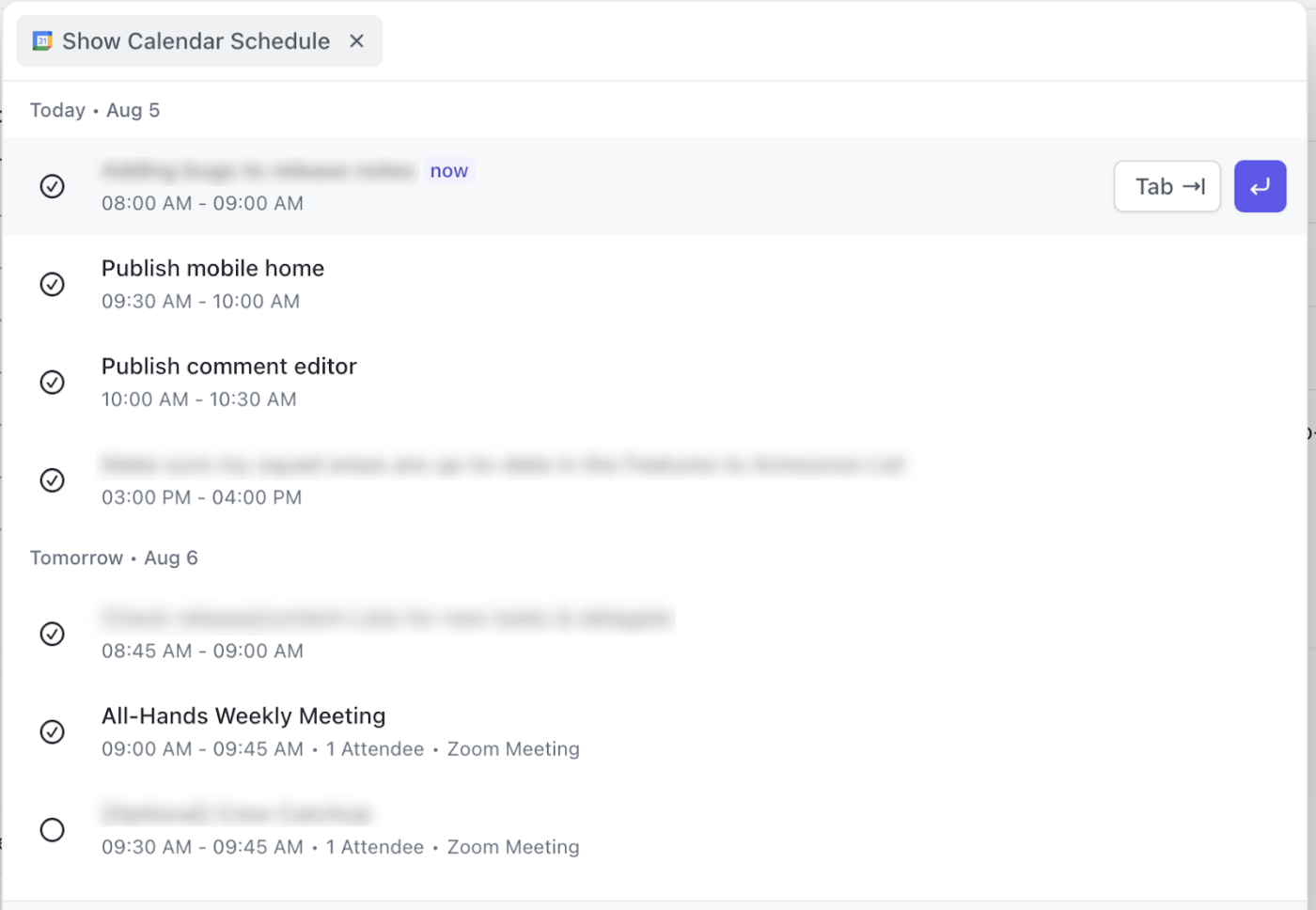
Meeting notes scattered across apps? Not anymore.
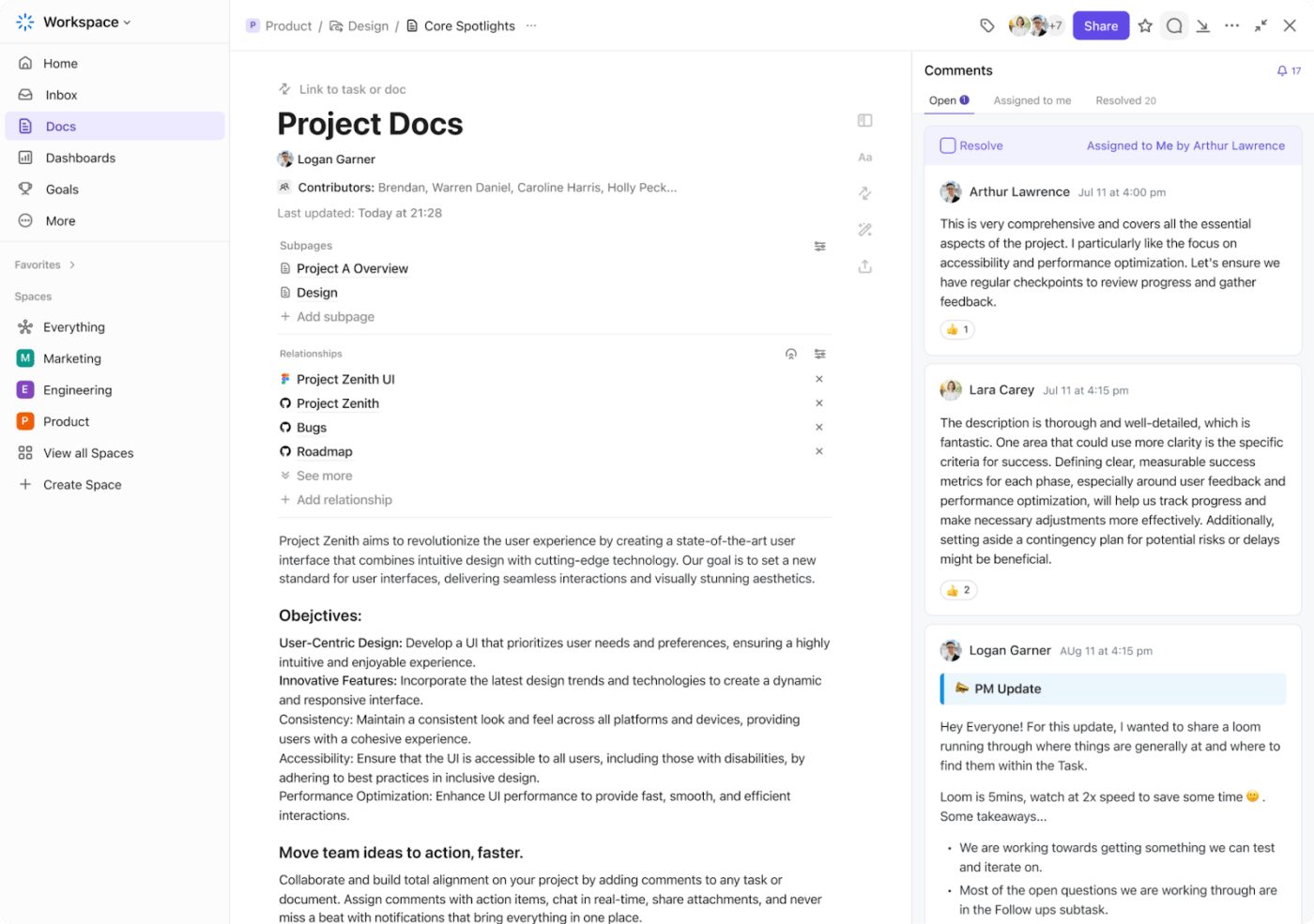
ClickUp Docs lets you create detailed, collaborative documents for each check-in. You can structure agendas, add action items, and even assign tasks directly in the Doc.
Since everything is stored in ClickUp, you can access past notes for context anytime, anywhere.
For instance, you can prepare a check-in agenda with sections like ‘Progress on last week’s goals’ or ‘Challenges and solutions.’ During the meeting, update the Doc in real time, ensuring everyone is aligned.
Discussing action items is one thing—ensuring they’re completed is another.
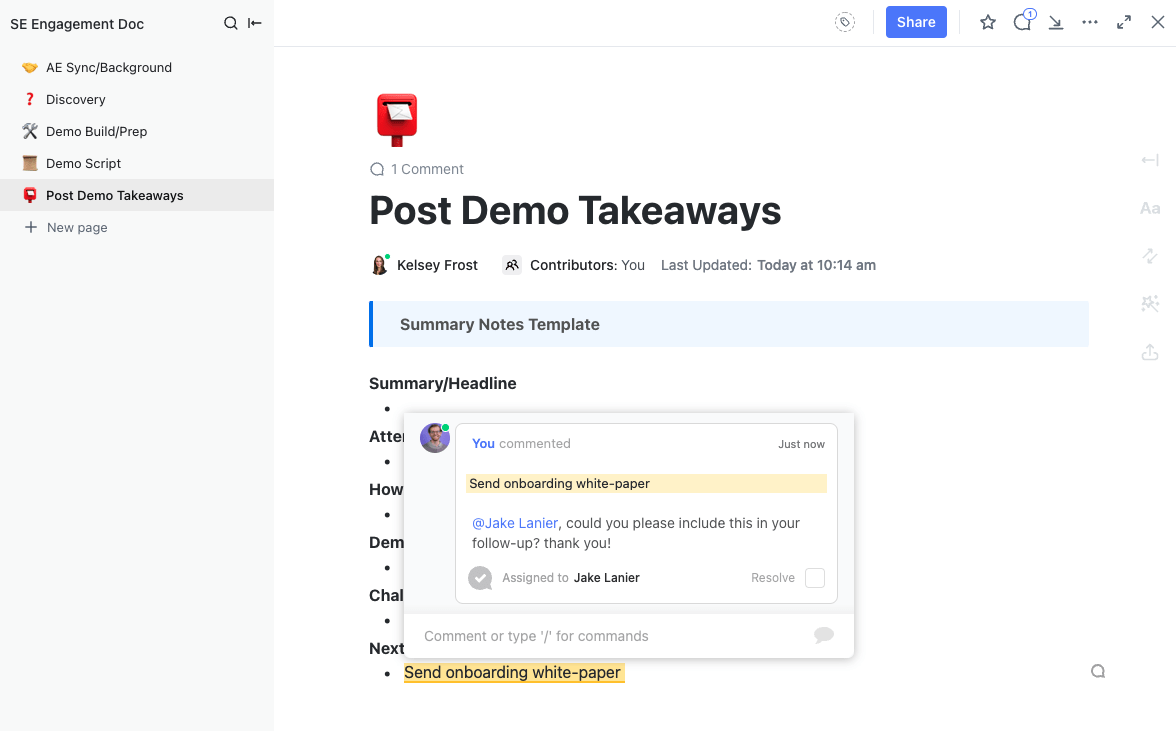
ClickUp Assign Comments turn feedback or ideas into actionable tasks. Assign a comment to a team member, set a due date, and track progress directly from the Doc.
For example, if an employee mentions the need for additional training during the check-in, you can assign a comment to HR to schedule a workshop.
What’s more, effective check-ins start before the meeting itself.
ClickUp Forms enables you to collect feedback or gather insights ahead of time. Forms are fully customizable, allowing you to ask specific questions tailored to your team’s needs.
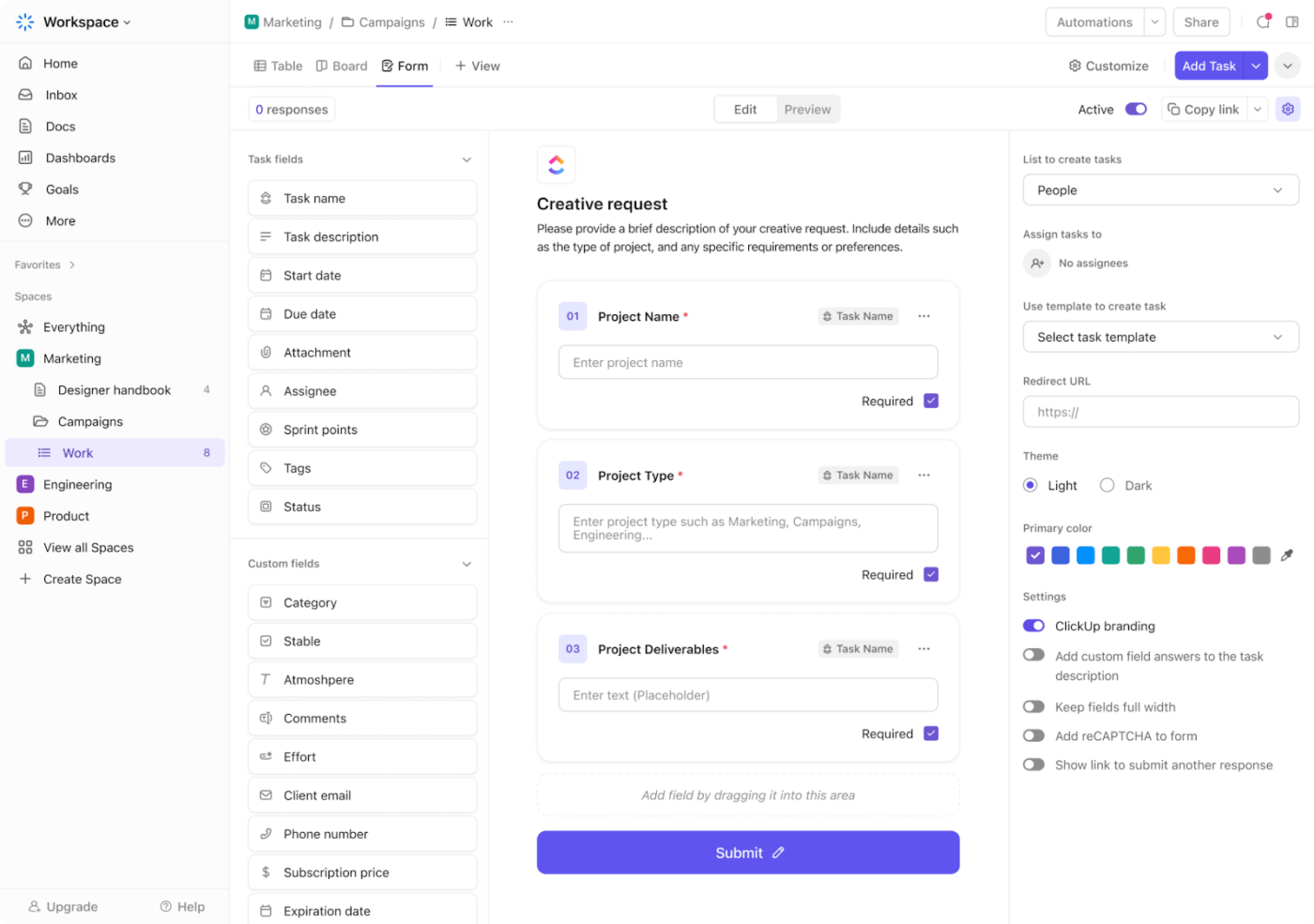
📌 Example: Before a check-in, send a form asking questions like:
And after a check-in, ask:
You can also share a form to ask development check-in questions:
The responses will be automatically organized in ClickUp, helping you identify trends or issues that need immediate attention.
You can also consider pairing the ClickUp Employee Feedback Template with the ClickUp Employee Engagement Template to structure your efforts better.
Blank pages are intimidating. ClickUp’s templates solve this problem by offering pre-designed formats for check-in agendas, follow-ups, and feedback collection.
📌 Example: You can use the ClickUp One-on-One Meeting Template that includes sections for:
This template keeps your meetings on track, offering agendas tailored to different objectives. You can focus on performance reviews, feedback sessions, or career development talks, ensuring every topic gets the attention it deserves.
The one-on-one template includes sections for notes, action items, and follow-ups, so every meeting stays focused and productive. It also promotes a consistent format, making it easy to track progress and revisit past discussions.
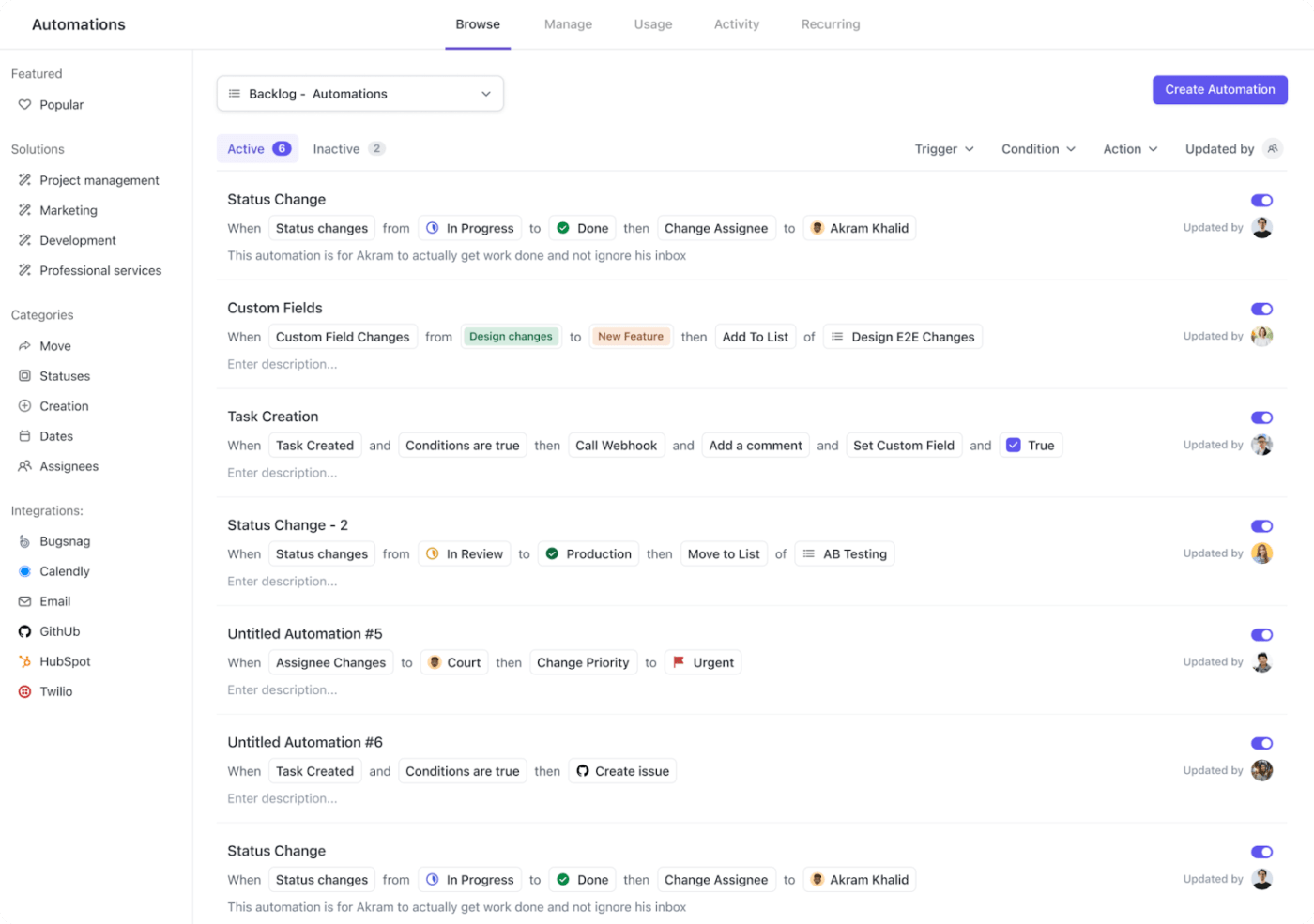
ClickUp Automations saves you from manual follow-up fatigue. Set triggers to send reminders about action items or follow-ups automatically.
📌 Example: If an employee commits to completing a task by next week, you can set an automation to send them a reminder in a few days.
Want to bring external tools into the mix?
The ClickUp and Zoom Integration streamlines scheduling and hosting your meetings. You can instantly generate Zoom links, add them to meeting invites, and sync everything with the calendar for a seamless scheduling experience.
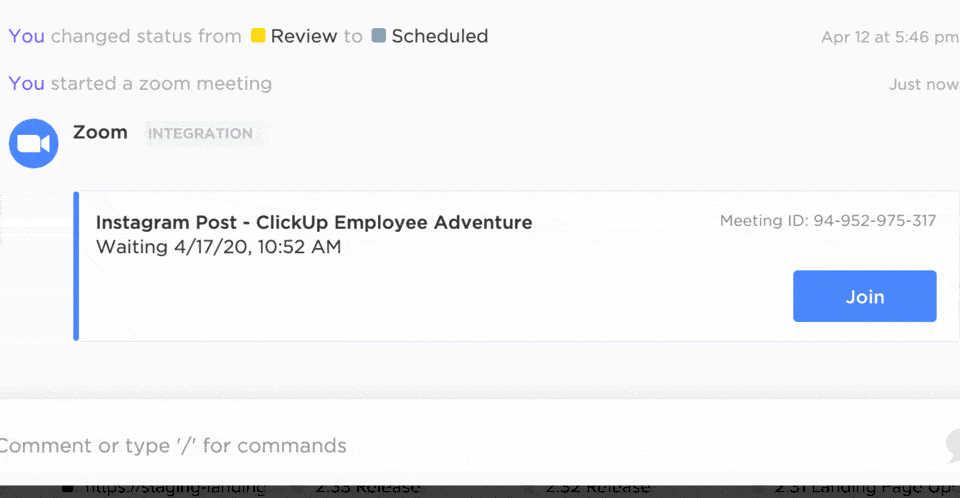
After all those check-ins, you’ll want to see how things are progressing.
ClickUp Dashboards let you track everything in one visual overview. You can track progress and follow-ups and even see engagement levels across your team.
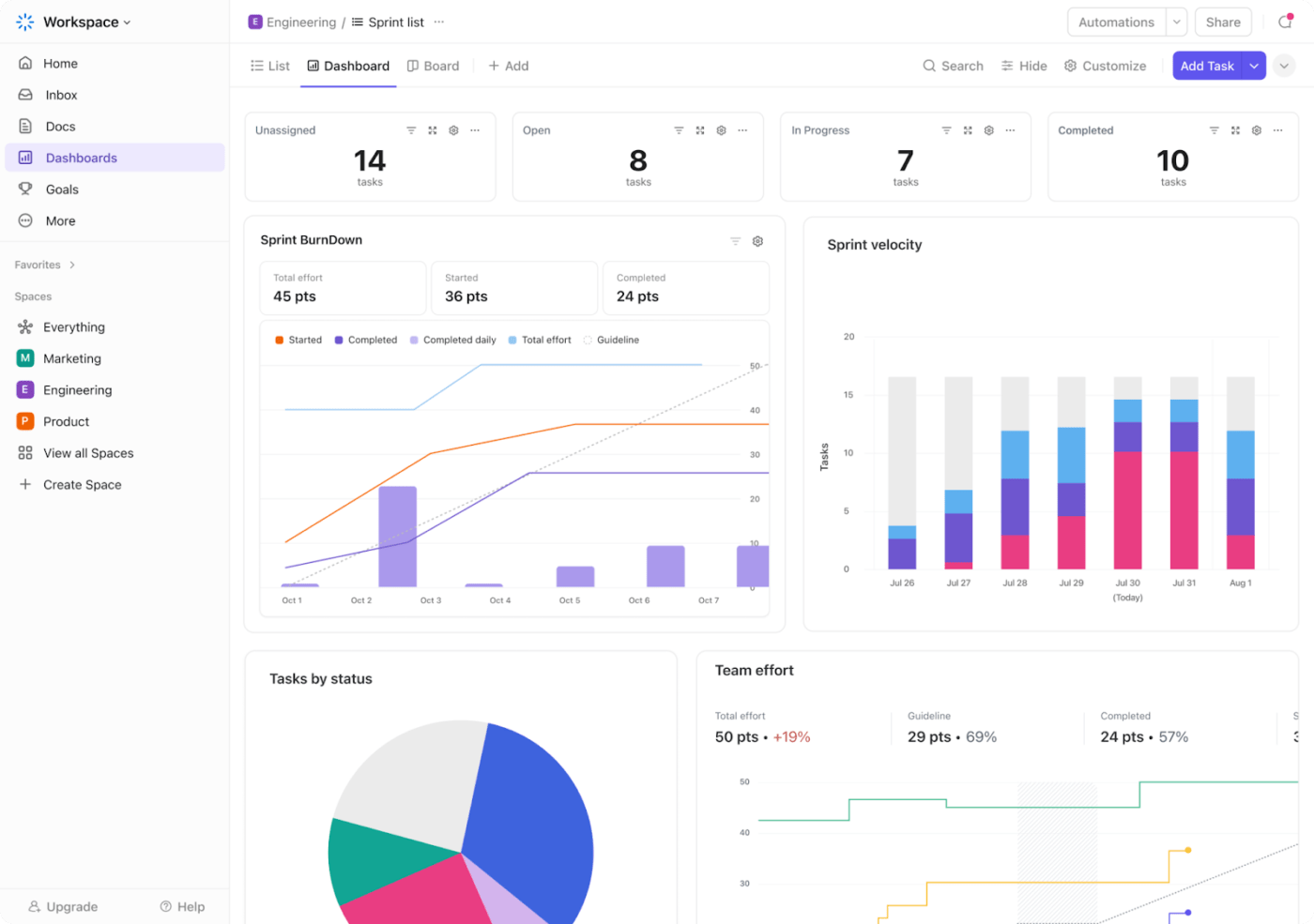
Dashboards display everything from task completion rates to recurring feedback themes.
For example, set up a Dashboard that tracks pre-check-in survey completion rates and identifies recurring feedback about workload challenges.
🔍 Did You Know? Research by Kincentric shows that 91% of employees who received a consistent employee experience reported higher levels of engagement.
To make the most of team check-ins, it’s important to follow best practices that keep everyone engaged, focused, and productive. Let’s dive into some key strategies that can strengthen your team dynamic. 🔄
In virtual or hybrid teams, it’s crucial to manage the flow of communication during check-ins.
Encourage everyone to use video to increase engagement, as it helps build connections. Use collaborative tools like screen sharing, shared documents, or whiteboards to make the check-in more interactive.
In virtual check-ins, be sure to manage time zones and technology issues to avoid frustrations.
🧠 Fun Fact: A McKinsey survey found that 83% of employees see working remotely as a big win for productivity, with many highlighting how it helps them work more efficiently with a proper work-life balance.
Take time to acknowledge team members’ achievements during check-ins. Even small wins contribute to the team’s overall success and morale. Celebrating progress helps create a positive atmosphere and motivates everyone to keep pushing forward.
Recognition doesn’t have to be grand—simply acknowledging efforts and contributions can go a long way toward boosting employee well-being.
Check-ins should focus on progress, not micromanagement.
Trust your team members to handle their tasks and avoid the temptation to oversee every small detail. Use check-ins to provide support, guidance, and feedback rather than stepping in and taking control of every aspect of their work. This encourages autonomy and boosts team morale.
Don’t feel locked into one format for check-ins. If something isn’t working or the team feels a particular format is outdated, be open to changing things up.
For example, some check-ins work better as a roundtable discussion, while others might benefit from a more structured update format. Adapting the meeting format to what works best for your team will ensure that check-ins remain relevant and productive.
📖 Also Read: How to Say Just Checking in Professionally at Work
Team check-ins are a simple yet powerful way to keep your team connected, aligned, and motivated. Daily updates, weekly reviews, or monthly reflections all help tackle challenges, celebrate wins, and keep everyone focused on what matters most.
ClickUp makes these check-ins easier and more efficient. You can schedule meetings, create collaborative agendas, track progress, and gather feedback—all in one place. With templates, automations, and real-time updates, staying on top of team communication has never been this smooth. Sign up for ClickUp today and see the difference it makes!
© 2025 ClickUp